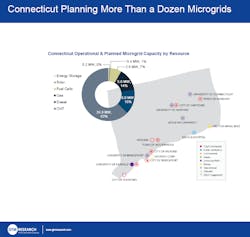Connecticut yesterday launched its long-awaited third-round of microgrid funding, which will offer $30 million in new grants.
The Department of Energy and Environmental Protection (DEEP) will begin accepting applications December 10. A project can win $3- to $5 million. Both municipal and private microgrids can apply.
The $30 million adds to the $23 million in microgrid funding that the state already has awarded in the first two rounds. In all, 11 microgrid projects have won funds since the program began in 2012.
Connecticut was slow to roll out the third round of microgrid funding because it wanted to evaluate the effectiveness of the first two rounds and then modify the third round accordingly.
A key difference this time is that projects are not being asked to compete against each other. Instead, each project will be considered on its own merit, an approach that acknowledges the highly customized nature of microgrids. The state will accept applications on a rolling basis until the $30 million is depleted.
The state has set aside $20 million of the funds specifically for municipal projects, which are eligible for up to $3 million each. Applicants can win an additional $2 million if they are located in a ‘priority town’ that is eligible for US Department of Agricultural Rural Community Energy Assistance Program. (See map below.)
DEEP will fund a maximum of $7,000/kW (per island peak load kW) for each project. If the grant does not cover the full cost of the microgrid, applicants must seek matching funds for the remainder. In evaluating applications, DEEP will consider the level of matching funds.
Who is eligible?
To be eligible an applicant must show how the microgrid will serve critical facilities, such as hospitals, police departments, water treatment plants and similar facilities, during a power outage.
Before seeking the grant money, projects must apply for an interconnection agreement with their utility, if the utility requires one.
DEEP requires the projects include at least two critical facilities interconnected with distributed energy within a clearly defined electrical boundary. The microgrid also must:
- Act as a single, controllable entity with respect to the central grid
- Be able to connect and disconnect (island) from the grid
- Have a minimum 15-year life span
- Demonstrate that they can finance the development and operation of the microgrid.
Non-municipal microgrids must also be able to provide at least 80 percent of their power requirement for at least 7,000 hours when they are grid-connected.
Before it begins an indepth analysis of an application, the state will review it to make sure it meets threshold requirements, a process that is expected to take about two weeks. During that time, DEEP may seek more information. Applicants will have 90 days to supply all of the needed information to keep their place in the review queue.
After DEEP approves an application, the state Bond Commission must approve release of the money, a process that can take up to three months because the commission only meets once a quarter.
Winners will be required to file a report with the state about the microgrid’s operations for the first five years.
Positive market sign, but…
Lawmakers approved the microgrid grant program in June 2012 after a hurricane and freak October snow storm in 2011 caused widespread power outages.
Other states in the region began pushing for microgrid development several months later. Their impetus was the devastation wrought by Superstorm Sandy in October 2012.
As the first state to test microgrid grants, Connecticut’s program faced some stumbling blocks. Several projects funded in the early rounds have been slow to come online.
“The announcement of a third round of funding is a very positive sign for the market. Connecticut was one of the initial adopters of a major state-wide microgrid incentive program back in 2012. Two funding rounds later, however, actual project development has seen its fair-share of challenges,” said Omar Saadeh, senior grid analyst for GTM Research. “Few of the state’s proposed microgrids are operational as developers have been plague by vendor bankruptcies (e.g., ClearEdge), lack of adequate planning and problems securing financing due to insufficient projected returns,” he said.
As has been the trend, particularly in the Northeast, it’s likely that new projects will include a high degree of natural gas-fired generation and combined heat and power, he added
“That being said, the economics for microgrid energy storage have become increasingly attractive — 44 percent of operational microgrids integrate some form of battery storage, led by universities and research facilities. Microgrid energy storage has been a recent phenomenon, with 92 percent of deployments commissioned since 2012. Lithium-ion is the most popular battery storage type, accounting for 40 percent of operational and 60 percent of planned capacity, followed by lead acid and sodium sulfur,” Saadeh said.
Application materials for the third round of Connecticut microgrid funding are posted on the DEEP website.
Track microgrid grants and RFPs by subscribing to the free Microgrid Knoweldge newsletter.







